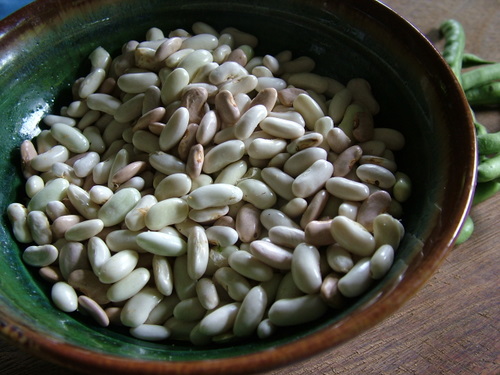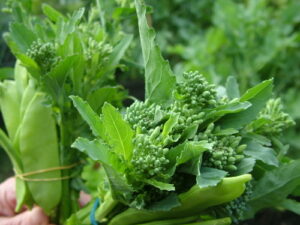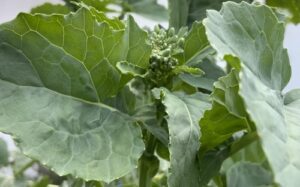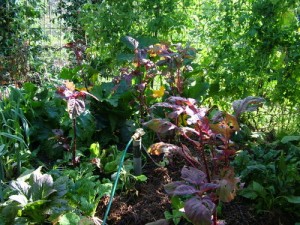We’re eating green beans just about every day at the moment – in salads and stews and sautés and steamed vegetables – and and I’m still harvesting about this many beans for drying every few days. Beans are one of my real staples – super easy to grow, prolific, a good source of protein, soluble fiber, folate and a whole range of minerals, and the basis for a big range of recipes.
 I grow all climbing varieties these days. With my fortress fenced gardens, I am so miserly with space that I choose climbers over dwarf varieties of everything possible. From September through to June, the south-side fence on at least half of my garden beds is growing beans of one variety or another, rotating with cucumbers and tomatoes. Since, in the southern hemisphere, the sun is always to the north, they can occupy dozens of square metres of vertical space without shading anything else in the bed, taking up just a few centimetres of precious ground space.
I grow all climbing varieties these days. With my fortress fenced gardens, I am so miserly with space that I choose climbers over dwarf varieties of everything possible. From September through to June, the south-side fence on at least half of my garden beds is growing beans of one variety or another, rotating with cucumbers and tomatoes. Since, in the southern hemisphere, the sun is always to the north, they can occupy dozens of square metres of vertical space without shading anything else in the bed, taking up just a few centimetres of precious ground space.
I have four current favourite varieties: Blue Lake for green french beans, and for the white seeds as a cannellini bean substitute, Purple Kings as a gutsy flavoured green bean and for the pink seeds as a kidney bean substitute, Brown Seeded Snake Beans for salads and stir fries and for the little red seeds as an Azuki bean substitute, and Madagascar beans for their large maroon mottled beans that work in Lima Bean recipes. But I am still always tempted to try new varieties every year.
I plant a box of beans of one kind or another every month from September through to February. With big seeds like peas and beans, I skip the seed germinating stage and plant straight into seedling raising mix – mostly good compost with a bit of creek sand for drainage. For alkaline lovers like peas and beans I add a bit of wood ash to the mix to raise the pH. The box lives in the shadehouse for a month or so, giving me a month more bearing time out of the cucumbers or tomatoes that are occupying the space. At planting out time, I can plant the very advanced seedlings out, paper or leaf or banana bark tube and all.
Beans are symbiotic with a kind of bacteria that forms little nodules on the roots and fixes nitrogen out of the atmosphere. Most of the nitrogen goes into the proteins in the beans, but there is still a bit of benefit to the soil, so leafy green nitrogen lovers often do well around beans. Things in the onion family (especially garlic) tend to be antibiotic, so unfriendly to the bacteria – best to avoid planting beans next to garlic or onions, in time or space.
 Picking the green beans before they mature keeps the plants producing, so it is best to keep picking if you want to keep producing green beans. But once the next round of beans starts bearing, I let the earlier round go to beans for storage. In fine, dry weather you can let the beans completely mature and dry on the plant. But if there is prolonged wet, humid weather, they will grow mould, and it is best to pick at the yellow stage. Don’t pick too early though, or they won’t harden off.
Picking the green beans before they mature keeps the plants producing, so it is best to keep picking if you want to keep producing green beans. But once the next round of beans starts bearing, I let the earlier round go to beans for storage. In fine, dry weather you can let the beans completely mature and dry on the plant. But if there is prolonged wet, humid weather, they will grow mould, and it is best to pick at the yellow stage. Don’t pick too early though, or they won’t harden off.
They’re simple to shell and dry. I just leave them in a colander on the verandah for a few days till they feel hard to a fingernail, then store in a glass jar.
To Cook:
Beans have a kind of complex, indigestible sugar called oligosaccharide in their skin. It’s what gives them their reputation for fart-producing. Oligosaccharides are water soluble, so soaking gets rid of them. Pretty well any bean recipe starts with “soak your beans”. You can “fast soak” by bringing the beans to the boil in water, soaking for half an hour or so, then changing the water and cooking. But it always works better to soak in cold water for the day or overnight. If you are planning beans for dinner, just put them on to soak before you go to work for the day.
You need about ¹/3 cup of dry beans per person for meals where the beans are the star. They expand quite a lot – at least double the volume – as they absorb water. Even after soaking, they need to be cooked in at least an equal amount of water (1 cup of water for each cup of soaked beans), and they’ll expand again (so don’t fill the pot too full).
A pressure cooker is a fantastic tool. My pressure cooker, a gift from my mum, is one of my kitchen treasures. It is stainless steel and expensive enough to consider as an “investment”. But if nobody is getting your gift hints, look around op shops. Find one with the little weight on top and the seal around the lid in good condition – new seals are available but can be hard to find.
Fresh beans that have been air dried are much faster to cook than bought beans. I suspect that bought beans, specially imported ones, may have been overheated in drying. My Blue Lake cannellini beans cook in just 8 minutes in the pressure cooker after pre-soaking. The slightly larger Purple Kings take just 10 minutes. This means that the whole convenience aspect of canned beans is irrelevant and it’s easy to avoid the BPAs in can lining, as well as the too much sugar, salt, food miles and dubious agricultural chemicals.




Fantastic post! I love beans… we are eating purple king beans and dwarf beans at the moment, but trying to allow the rattlesnake beans to develop so we can dry the bean part of them! It’s hard not to want to pick & eat them all…
Pingback:The Breakfast Challenge – Frijoles Con Queso (Cheesy Beans)
Pingback:Picking Up Something for Dinner
Pingback:Bean Burgers
Pingback:Chili Con Kanga With Avocado, Lime and Coriander Salsa
Pingback:The 2013 Challenge – Food to Share
Pingback:Ful Medames without the Ful (or Lemony, Garlicy, Peppery Beans)